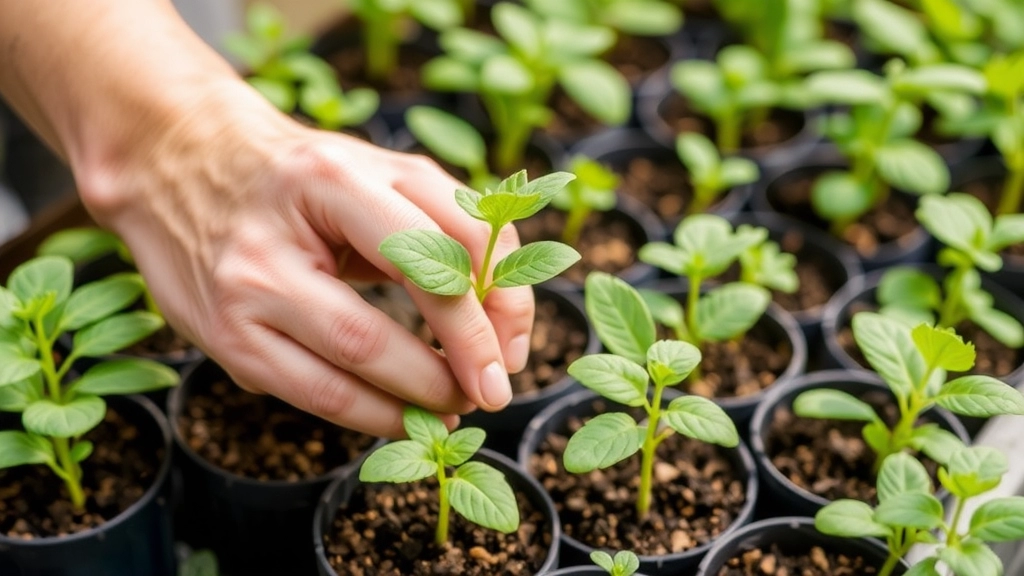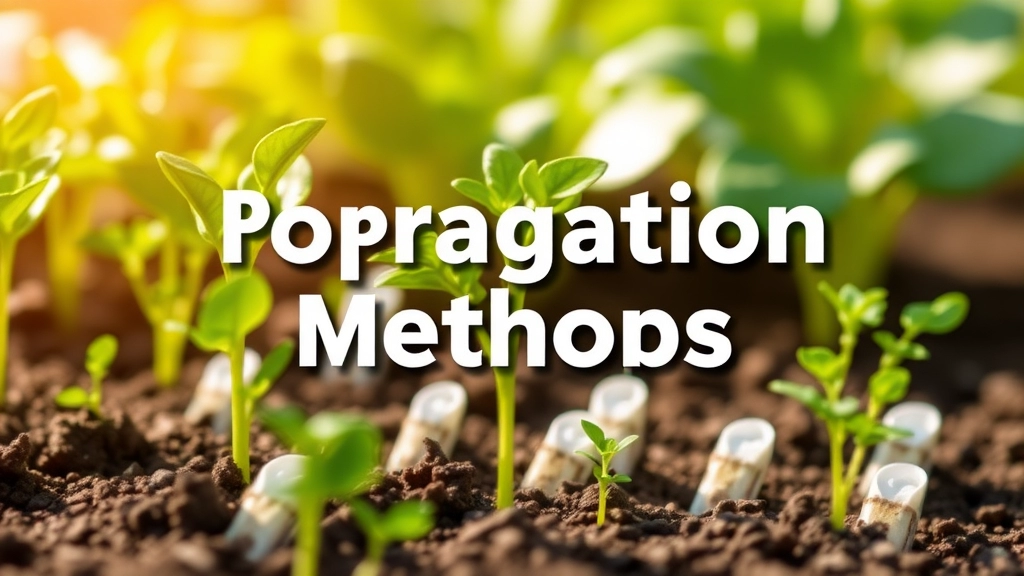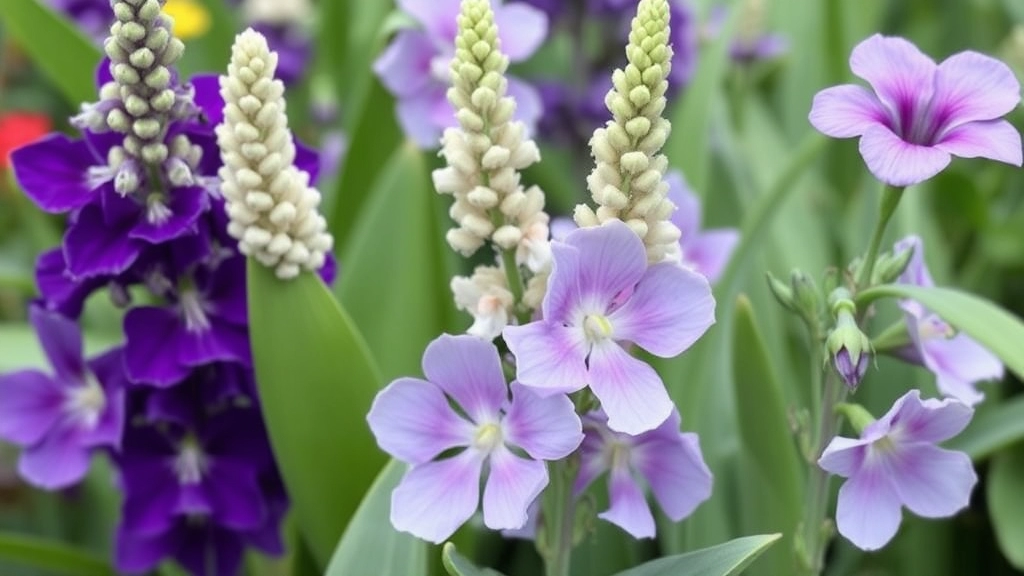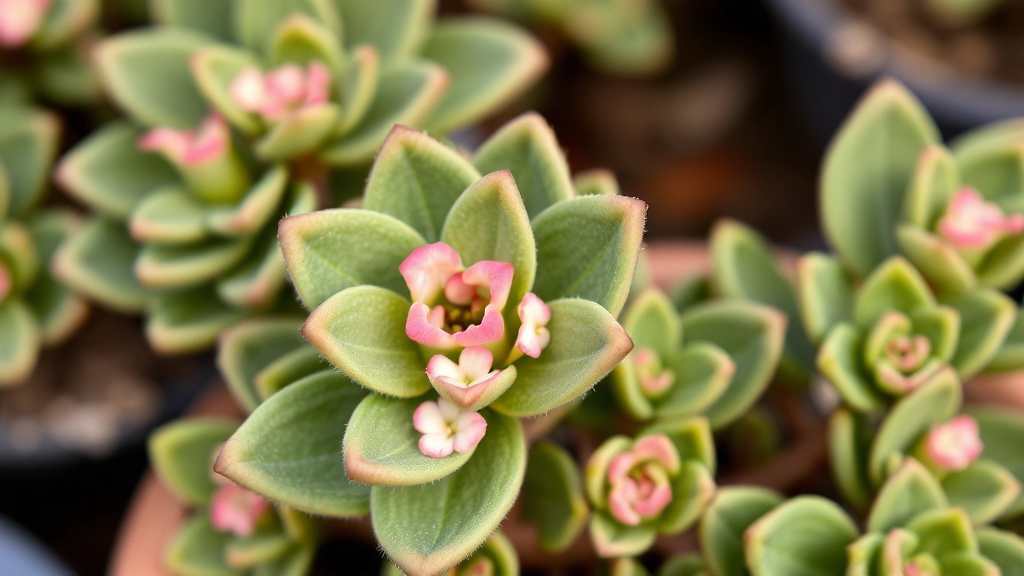Welcome, plant enthusiasts!
Today, we’re diving into the fascinating world of Kalanchoe bouvetii, a hidden gem in the succulent kingdom. This tropical beauty, hailing from the sun-drenched landscapes of Madagascar, is about to become your new green obsession. With its lush, fleshy leaves and low-maintenance charm, Kalanchoe bouvetii is the perfect plant for both novice gardeners and seasoned plant parents alike.
In this comprehensive guide, we’ll explore everything from its unique botanical features to expert care tips, propagation methods, and even some surprising benefits. Whether you’re looking to add a touch of exotic flair to your indoor jungle or seeking a resilient outdoor companion, Kalanchoe bouvetii has got you covered. So, let’s embark on this green adventure and uncover the secrets of this captivating succulent!
Overview of Kalanchoe bouvetii
Hey there, plant lovers! Let’s chat about Kalanchoe bouvetii.
This succulent’s a real gem in the Kalanchoe family.
Native to Madagascar, it’s got some serious tropical vibes.
But don’t let that fool you – it’s tough as nails.
Kalanchoe bouvetii’s known for its thick, fleshy leaves.
They’re a gorgeous green, sometimes with a reddish tinge.
What’s cool? It’s a low-maintenance plant that thrives on neglect.
Perfect for busy folks or those with a, shall we say, less-than-green thumb.
It’s got this unique ability to propagate from leaf cuttings.
Talk about a plant that keeps on giving!
Kalanchoe bouvetii’s not just pretty – it’s practical too.
Some folks use it in traditional medicine.
But let’s be real – most of us just love it for its looks.
It’s a stunner in rock gardens or as a houseplant.
So, whether you’re a succulent newbie or a seasoned pro, Kalanchoe bouvetii’s worth a shot.
Trust me, this little beauty might just become your new plant obsession.
Botanical Description of Kalanchoe bouvetii
Alright, let’s dive into the nitty-gritty of Kalanchoe bouvetii. This succulent’s a real head-turner, and I’ll tell you why.
First off, picture this: a compact, bushy plant that’s not trying to take over your whole windowsill. That’s our Kalanchoe bouvetii for you. It’s got this neat, tidy look that’s perfect for those of us who want a bit of green without the hassle.
Now, let’s break it down:
Leaves:
- Thick and fleshy (classic succulent move)
- Oval-shaped with scalloped edges
- Usually a deep green, but can blush red in bright light
Stems:
- Sturdy and upright
- Can get a bit woody as they age (like some of us, am I right?)
Flowers:
- Small and star-shaped
- Typically yellow or orange
- Bloom in clusters at the end of stems
Height:
- Usually stays under 30cm (1 foot)
- Can spread out to about the same width
Root System:
- Shallow but efficient (doesn’t need much soil)
Here’s the thing about Kalanchoe bouvetii – it’s not just a pretty face. This plant’s built to survive. Those thick leaves? They’re water storage tanks. The waxy coating? Nature’s sunscreen.
I remember when I first got mine. It was this tiny little thing, barely bigger than my palm. Fast forward a year, and it’s this lush, full plant that’s become the star of my succulent collection.
But here’s a pro tip: if you want yours to really thrive, give it plenty of light. I stuck mine in a south-facing window, and it’s been living its best life ever since.
Kalanchoe bouvetii might not be the flashiest plant out there, but it’s got charm in spades. It’s like that friend who’s always reliable – low maintenance, but always there to brighten up your day. If you’re looking for a similar low-maintenance succulent, you might want to check out the Kalanchoe tomentosa ‘Teddy Bear’, which is known for its fuzzy leaves and easy care. Another interesting variety to consider is the Kalanchoe pinnata, also known as the “life plant” due to its ability to produce plantlets on its leaves.
Natural Habitat and Distribution
Ever wondered where Kalanchoe bouvetii calls home? Let’s dive in.
This succulent’s got a pretty specific stomping ground.
Kalanchoe bouvetii is native to Madagascar. Yep, that big island off Africa’s east coast.
But here’s the kicker – it’s not spread all over. It’s picky.
You’ll find it in the central highlands of Madagascar.
Why there? Well, it’s all about the climate and terrain.
These areas are typically dry and rocky. Perfect for a tough little succulent.
The central highlands have a unique microclimate.
It’s cooler than the coastal areas, with less rainfall.
Kalanchoe bouvetii thrives in these conditions.
It’s adapted to survive with minimal water and lots of sun.
In the wild, you might spot it clinging to rocky outcrops.
Or nestled in well-drained soil between rocks.
It’s a master of making the most of harsh conditions.
But here’s the thing – it’s not common to find it in the wild anymore.
Over-collection and habitat loss have taken their toll.
That’s why it’s crucial we grow and preserve it in cultivation.
So, next time you see a Kalanchoe bouvetii, remember its roots.
It’s a little piece of Madagascar’s unique ecosystem, right in your home.
Cultivation and Care Tips

Alright, let’s dive into growing Kalanchoe bouvetii like a pro. Trust me, it’s not rocket science, but there are a few tricks up my sleeve that’ll make your life easier.
Light and Location
First things first, these succulents are sun-lovers. They’re basically the beach bums of the plant world. Here’s the deal:
- Bright, indirect light is their jam
- A few hours of morning sun won’t hurt
- Avoid harsh afternoon rays – they’ll scorch faster than my pasty skin at the beach
Pro tip: If you’re growing them indoors, a south-facing window is your best bet. Just keep an eye out for any sunburn on those leaves.
Soil and Potting
Now, let’s talk dirt. Kalanchoe bouvetii isn’t fussy, but it does have some preferences:
- Well-draining soil is a must
- Mix regular potting soil with some perlite or sand
- A pot with drainage holes is non-negotiable
Think of it this way – these plants hate wet feet more than I hate wearing soggy socks.
Watering
Here’s where most people mess up. These succulents are drought-tolerant, so less is more:
- Water thoroughly, then let the soil dry out completely
- In winter, cut back even more
- If in doubt, don’t water
Remember, it’s easier to save an underwatered Kalanchoe than an overwatered one. Trust me, I’ve learned this the hard way.
Temperature and Humidity
Good news – Kalanchoe bouvetii isn’t too picky about temperature or humidity. They’re like that easy-going friend who’s up for anything:
- They’re happy in normal room temperatures
- Can tolerate a bit of cold, but not frost
- Don’t need extra humidity
Just keep them away from drafts and sudden temperature changes. They’re tough, but not invincible.
Fertilising
These plants aren’t big eaters, but a little snack now and then doesn’t hurt:
- Feed with a balanced, water-soluble fertiliser
- Do this once a month during growing season
- Skip the fertiliser in winter
Think of it as giving your plant a little energy boost, not a full-on feast.
Pruning
Last but not least, let’s talk pruning. It’s not essential, but it can help keep your Kalanchoe bouvetii looking its best:
- Remove dead or yellowing leaves
- Pinch off the tips to encourage bushier growth
- If it gets too leggy, don’t be afraid to give it a haircut
Remember, pruning is like a spa day for your plant. It might seem harsh, but your Kalanchoe will thank you for it.
So there you have it – everything you need to know about cultivating Kalanchoe bouvetii. Stick to these tips, and you’ll be well on your way to becoming a succulent superstar. Just remember, every plant is unique, so don’t be afraid to adjust based on what your Kalanchoe is telling you. If you’re interested in other Kalanchoe varieties, check out the Kalanchoe tomentosa varieties for some fuzzy-leaved options. And if you’re curious about the meaning behind these plants, explore the Kalanchoe blossfeldiana meaning. Happy growing!
Common Pests and Diseases
Let’s chat about the nasty critters and ailments that can bug your Kalanchoe bouvetii.
Pests:
- Mealybugs: These little cotton-ball lookalikes love to suck the life out of your plant.
- Spider mites: Tiny but mighty, they’ll leave your leaves looking speckled and sad.
- Aphids: Green, soft-bodied, and always hungry for your Kalanchoe’s sap.
Diseases:
- Root rot: Overwatering’s evil twin. Your plant’s roots turn to mush.
- Powdery mildew: Looks like someone dusted your plant with flour. Not cool.
- Leaf spot: Brown or black spots on leaves. Kinda like plant acne.
How to keep your Kalanchoe bouvetii healthy:
- Don’t overwater. Seriously, it’s the number one killer.
- Give it enough light, but not too much. Think Goldilocks zone.
- Keep an eye out for pests. Catch ’em early, and you’ll save yourself a headache.
- Good air circulation is your friend. Helps prevent fungal issues.
- Use clean tools when pruning. No need to spread diseases around.
Remember, a healthy Kalanchoe bouvetii is more resistant to pests and diseases.
Keep it happy, and it’ll keep you happy. Simple as that.
Propagation Methods

Alright, let’s dive into how we can make more of these awesome Kalanchoe bouvetii plants. Trust me, it’s not rocket science, and you’ll be surprised at how easy it can be.
Leaf Cuttings: The Lazy Person’s Dream
Here’s the deal: leaf cuttings are your best friend if you’re looking for a low-effort way to propagate. I mean, who doesn’t love a method that’s basically “set it and forget it”?
- Snip off a healthy leaf
- Let it dry for a day or two (this helps prevent rotting)
- Stick it in some well-draining soil
- Water sparingly and wait
Boom! In a few weeks, you’ll start seeing tiny plantlets forming at the base of the leaf. It’s like magic, but better because it’s science.
Stem Cuttings: For When You’re Feeling a Bit More Ambitious
If you’re up for a slightly more hands-on approach, stem cuttings are the way to go. Here’s how:
- Cut a stem about 4-6 inches long
- Remove the lower leaves
- Let it callous over for a day
- Plant in a mix of perlite and cactus soil
- Keep it moist but not waterlogged
Pro tip: Use a rooting hormone if you want to speed things up. It’s like giving your cutting a little pep talk.
Division: The “Divide and Conquer” Method
Got a big, bushy Kalanchoe bouvetii? Division might be your best bet:
- Carefully remove the plant from its pot
- Gently separate the roots into smaller clumps
- Replant each clump in its own pot
It’s like giving your plant roommates their own apartments. Everyone wins!
Seeds: For the Patient Gardener
Look, I’ll be honest. Growing Kalanchoe bouvetii from seeds is a bit like watching paint dry. It takes forever and it’s not exactly thrilling. But if you’re into delayed gratification:
- Sow seeds on the surface of well-draining soil
- Keep them warm and moist
- Wait… and wait some more
In about 2-3 weeks, you might see some action. Just don’t hold your breath, okay?
The Bottom Line
Propagating Kalanchoe bouvetii isn’t rocket science. Whether you’re a lazy gardener or a green-thumbed enthusiast, there’s a method that’ll work for you. Just remember: patience is key, and don’t be afraid to experiment. After all, that’s half the fun of gardening, right? If you’re looking for more variety, you might want to check out the Kalanchoe tomentosa varieties for some interesting options. And if you’re new to Kalanchoe care, learning how to care for Kalanchoe tomentosa can give you a good foundation for caring for other Kalanchoe species as well.
Uses and Benefits of Kalanchoe bouvetii
Let’s chat about why Kalanchoe bouvetii is more than just a pretty face.
Ornamental Appeal
First off, this plant’s a stunner in any garden or indoor space.
Its fleshy leaves and vibrant blooms make it a top pick for decorative purposes.
I’ve seen it jazz up rock gardens and add a tropical vibe to office desks.
Medicinal Potential
Now, here’s where it gets interesting.
Some folks swear by its healing properties.
Traditional medicine has used Kalanchoe species for ages.
Think skin conditions, inflammation, and even pain relief.
But hold your horses – always chat with a doc before trying any herbal remedies.
Air Purification
Like many succulents, Kalanchoe bouvetii’s a natural air freshener.
It gobbles up CO2 and pumps out oxygen, even at night.
Perfect for bedrooms, if you ask me.
Low-Maintenance Greenery
Busy bees, listen up.
This plant’s a champ at surviving neglect.
It’s drought-tolerant and doesn’t need constant fussing.
Ideal for newbie gardeners or those with a, let’s say, “forgetful” watering schedule.
Educational Tool
Got kids? Kalanchoe bouvetii’s great for teaching about plant care.
Its easy-to-observe growth patterns make it a fun science project.
Plus, it’s non-toxic, so no worries if curious fingers touch it.
Stress Relief
There’s something zen about caring for plants.
Tending to Kalanchoe bouvetii can be a calming ritual.
It’s like a mini-meditation session, minus the “om” sounds.
Gifting Option
Looking for a unique pressie?
A potted Kalanchoe bouvetii’s a thoughtful choice.
It’s the gift that keeps on growing – literally.
In a nutshell, Kalanchoe bouvetii’s not just a pretty plant.
It’s a multi-tasking marvel that brings beauty, potential health perks, and low-maintenance joy to your space.
Whether you’re a plant pro or a green thumb newbie, this succulent’s got something for everyone.
Popular Varieties and Hybrids

Alright, let’s dive into the world of Kalanchoe bouvetii varieties and hybrids. Now, I’ll be straight with you – this isn’t exactly a plant that’s got a ton of different cultivars floating around. It’s more of a niche species that plant nerds like us get excited about.
But hey, that doesn’t mean there’s nothing to talk about! Let’s break it down:
Pure Kalanchoe bouvetii:
- This is your standard, run-of-the-mill K. bouvetii. It’s got those thick, fleshy leaves and clusters of small, yellow flowers. Pretty cool on its own, if you ask me.
Hybrids:
Now, here’s where things get interesting. While there aren’t many named hybrids specifically for K. bouvetii, it’s been used in some breeding programs. Why? Well, it’s got some traits that breeders find useful:
- Drought tolerance: These suckers can handle dry spells like a champ.
- Compact growth: Great for folks who don’t have a ton of space.
- Unique leaf texture: Adds some visual interest to hybrid offspring.
Some Kalanchoe hybrids that might have a bit of K. bouvetii in their family tree:
- ‘Fang’: This one’s got teeth-like edges on its leaves. Spooky and cool!
- ‘Chocolate Soldier’: Dark, velvety leaves that look good enough to eat (but don’t, seriously).
- ‘Pink Butterflies’: Produces tiny plantlets on its leaves that look like little butterflies.
Now, I’m not saying these are direct hybrids of K. bouvetii – the Kalanchoe family tree is more tangled than my headphones after a run. But they show some traits that might have come from our buddy K. bouvetii.
Look, at the end of the day, whether you’re growing pure K. bouvetii or one of its distant cousins, you’re in for a treat. These plants are tough, interesting, and just plain fun to have around. If you’re interested in learning more about Kalanchoe varieties, check out the flowering Kalanchoe (Kalanchoe blossfeldiana), which is one of the most popular species in the genus.
So, next time you’re at a plant swap or scrolling through online nurseries, keep an eye out for K. bouvetii and its relatives. You might just find your new favorite green buddy. And if you’re looking to expand your Kalanchoe collection, why not try your hand at propagating Kalanchoe tomentosa? It’s a fun and rewarding process!
Troubleshooting Common Issues
Hey there, Kalanchoe bouvetii enthusiast!
Let’s chat about some common hiccups you might face with this cool succulent.
Yellowing Leaves
Seen those leaves turning yellow? Don’t panic!
It’s usually down to overwatering or poor drainage.
Quick fix: Ease up on the H2O and check your soil mix.
Leggy Growth
Is your plant stretching out like it’s reaching for the stars?
That’s a cry for more light, my friend.
Solution: Move it to a brighter spot, but avoid scorching direct sun.
Leaf Drop
Leaves falling off like it’s autumn? Not cool.
This could be stress from temperature changes or inconsistent watering.
Try this: Stick to a regular watering schedule and keep it cozy.
Pest Problems
Spotted some uninvited guests? Mealybugs and spider mites love Kalanchoe bouvetii.
Grab some neem oil or insecticidal soap and show those pests the door.
Root Rot
Mushy stems and wilting? Uh-oh, root rot alert!
Time for some plant surgery. Cut away the rot and repot in fresh, well-draining soil.
Slow Growth
Feeling like your plant’s hit the pause button?
It might be time for a nutrient boost or a bigger pot.
Give it some diluted succulent fertilizer and see if that perks it up.
Remember, Kalanchoe bouvetii is pretty chill. Most issues are easy to sort with a bit of TLC.
Keep an eye on your plant, adjust as needed, and you’ll be golden!
Frequently Asked Questions about Kalanchoe bouvetii
Alright, let’s dive into some burning questions about Kalanchoe bouvetii. I’ve been growing these beauties for years, and I’ve heard it all. So, let’s cut through the noise and get to the good stuff.
Is Kalanchoe bouvetii toxic to pets?
Look, I get it. You love your plants, but you love your furry friends more. The short answer? Yeah, it’s toxic. But don’t freak out. Most pets won’t chow down on it anyway. Just keep it out of reach, and you’re golden.
How often should I water my Kalanchoe bouvetii?
Here’s the deal: these guys are succulents. They’re like the camels of the plant world. Water them when the soil’s dry to the touch. In summer, that might be once a week. Winter? Maybe once a month. Trust me, it’s way easier to kill these with kindness than neglect.
Can I grow Kalanchoe bouvetii outdoors?
Depends where you live, mate. If you’re in a warm spot (think USDA zones 9-11), go for it. Anywhere else? Stick to pots you can bring inside when it gets chilly. These plants are tough, but they’re not miracle workers.
Why isn’t my Kalanchoe bouvetii flowering?
Ah, the million-dollar question. Nine times out of ten, it’s about light. These guys need bright, indirect light to show off their blooms. Not enough light? No flowers. Simple as that. But don’t go scorching them in direct sun either. It’s all about balance.
How do I propagate Kalanchoe bouvetii?
Easy peasy. Grab a leaf or stem cutting, let it callous over for a day or two, then stick it in some well-draining soil. Keep it moist but not soggy. In a few weeks, you’ll have a new plant. It’s like magic, but better because it’s real.
Is Kalanchoe bouvetii prone to any specific diseases?
Look, every plant has its kryptonite. For Kalanchoe bouvetii, it’s usually root rot from overwatering. But they can also get mealybugs or spider mites if you’re not careful. Keep an eye out, and you’ll be fine.
Can Kalanchoe bouvetii survive in low light conditions?
Let’s be real: they’ll survive, but they won’t thrive. Low light means leggy growth and no flowers. If you’re stuck with a dark corner, there are better plants for that. Give your Kalanchoe bouvetii the light it deserves.
How long does Kalanchoe bouvetii live?
With proper care, these plants can stick around for years. I’ve had some for over a decade. But here’s the thing: they might not look the same as when you bought them. They grow, they change, they evolve. That’s part of the fun.
Remember, growing Kalanchoe bouvetii isn’t rocket science. It’s about understanding what the plant needs and not overthinking it. Keep it simple, watch your plant, and you’ll do just fine. And if you mess up? Well, that’s how we learn, isn’t it?
Frequently Asked Questions about Kalanchoe bouvetii
How much light does Kalanchoe bouvetii need?
Kalanchoe bouvetii thrives in bright, indirect light. It can tolerate some direct morning sun but should be protected from harsh afternoon rays. Aim for 4-6 hours of bright light daily for optimal growth and flowering.
Is Kalanchoe bouvetii drought-tolerant?
Yes, Kalanchoe bouvetii is quite drought-tolerant. Its thick, fleshy leaves store water, allowing it to survive periods of drought. However, regular watering is still necessary for optimal health and growth.
Can Kalanchoe bouvetii be grown indoors?
Absolutely! Kalanchoe bouvetii makes an excellent indoor plant. It adapts well to indoor conditions as long as it receives adequate light. Place it near a bright window, but avoid direct sunlight which can scorch the leaves.
How do I propagate Kalanchoe bouvetii?
Propagation is easy with leaf or stem cuttings. Allow the cutting to callous over for a day or two, then plant it in well-draining soil. Keep the soil slightly moist until roots develop, which usually takes a few weeks.
What type of soil is best for Kalanchoe bouvetii?
Use a well-draining soil mix specifically designed for succulents or cacti. You can also create your own mix by combining regular potting soil with perlite or coarse sand to improve drainage.
How often should I fertilize my Kalanchoe bouvetii?
Fertilize sparingly during the growing season (spring and summer) with a balanced, water-soluble fertilizer diluted to half strength. Apply every 4-6 weeks. Avoid fertilizing in fall and winter when growth slows down.
Why are my Kalanchoe bouvetii’s leaves turning yellow?
Yellowing leaves often indicate overwatering or poor drainage. Ensure your plant is in well-draining soil and only water when the top inch of soil feels dry. Also check for signs of pests or nutrient deficiencies.
Is Kalanchoe bouvetii toxic to pets?
Yes, like many Kalanchoe species, K. bouvetii can be toxic if ingested by pets. Keep the plant out of reach of cats, dogs, and other curious animals to prevent accidental ingestion.

